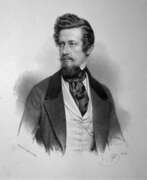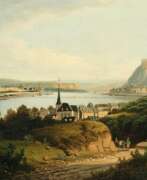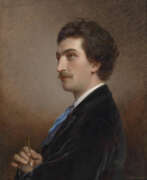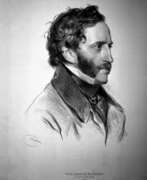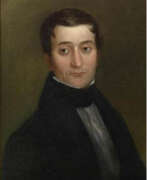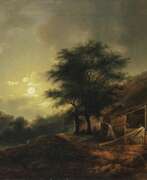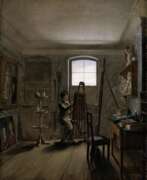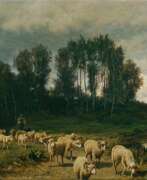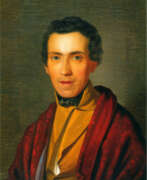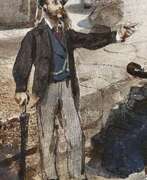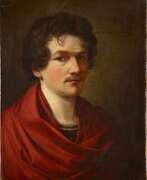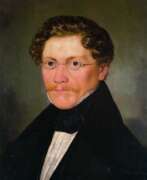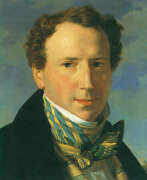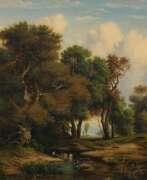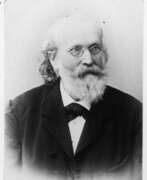Landscape painting Biedermeier
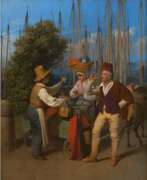



Heinrich Bürkel was a German artist of the mid-nineteenth century. He is known as a painter and graphic artist, representative of the Biedermeier style.
Heinrich Bürkel specialized in genre and landscape paintings, especially winter landscapes. He often used Staffage and depicted animals. His work showed the influence of the old Dutch and Italian masters. Bürkel enjoyed great popularity, his paintings were actively acquired for private collections, including in America. The master painted about 1000 paintings and created about 6000 drawings.
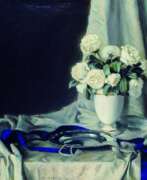

Paul Walter Ehrhardt was a German painter of the Munich School. Paul W. Ehrhardt studied with Max Thedy at the Grand Ducal Saxon Art School in Weimar and with Paul Hoecker at the Academy of Fine Arts in Munich. From 1906 he exhibited regularly in the Munich Glass Palace and at the Great Berlin Art Exhibition. Ehrhardt painted atmospheric Biedermeier interiors in muted tones. During the Nazi regime he was one of the most sought-after artists. Except for 1938, from 1937 to 1944 he was represented with 19 paintings at seven Great German Art Exhibitions in Munich, of which Hitler acquired three and the Nazi leader Joachim von Ribbentrop one. His works were represented at auctions until 2006.
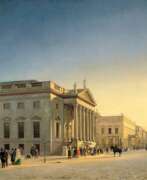

Johann Philipp Eduard Gaertner was a German painter of the second quarter of the 19th century, the Biedermeier era. He is known as a landscape painter, famous for his views of Berlin and other cities.
Eduard Gaertner created many architectural landscapes of Berlin, as well as St. Petersburg and Moscow during his travels to Russia. The value of these works is that they documented the appearance of the cities on the eve of the age of photography. Gaertner's painting style underwent a change after the death of King Friedrich Wilhelm III, his patron. In keeping with the cultural attitudes of Prussia's new ruler, the artist began to paint more romantic and idealized landscapes in which architecture played a decorative role.
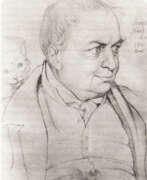

Joseph Anton Koch was an Austrian painter, draughtsman and printmaker, master of etching and illustration, novelist and representative of the classicist landscape in German art. In his native country he was associated with the Biedermeier aesthetic, and in Rome with the Nazarene society.
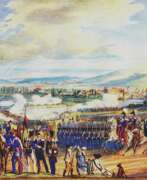

Gustav Kraus, also known as Gustav Friedrich or Gustav Wilhelm, was a Bavarian painter and lithographer.
He studied at the Munich Academy of Fine Arts and was admitted as a member of the Munich Art Society, and is considered a representative of the Biedermeier. In 1836 he founded his own lithographic publishing house. In his landscape works, Kraus combined topographical precision with artistic quality.
His urban and architectural vedute, depictions of historical events, including maneuvers, parades, processions, inauguration ceremonies, portraits of noble contemporaries, sketches of costumes and uniforms were published by many publishing houses. One of the most valuable of Kraus's works today is the depiction of the Oktoberfest procession of 1835 with 24 colorful lithographs.
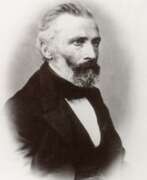

Friedrich Loos was an Austrian Biedermeier style painter, etcher and lithographer.
He studied at the Vienna Academy with Joseph Mössmer and also went on study tours through the Austrian Alpine regions. From 1835 to 1836 he lived in Vienna, and as of 1846 he sojourned in Rome. He then moved to Kiel, where he worked as a drawing teacher at the university as of 1863.
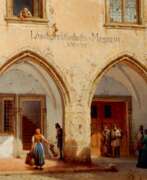

Michael Neher was a German painter and architectural decorator.
Michael studied at the Academy in Munich, in 1819 went to Italy and spent five years there, including two years in Rome, where he studied architectural painting in the studio of the artist Heinrich Maria von Hess, and in 1825 returned to Munich.
As a typical representative of the Biedermeier era, Neher produced many costume drawings and landscapes. He also became famous for his views of public places and architectural depictions of many Bavarian towns. From 1837, Michel Neher devoted himself entirely to architectural painting and traveled to improve his skills along the Rhine and to Belgium. In 1839 he painted several salons in Hohenschwangen Castle from designs by Schwind, Gasner and Schwanthaler. In 1876 he was made an honorary member of the Munich Academy.


Lorenzo Quaglio was an Italian-born German painter of the first half of the 19th century. He is known as a painter, landscape painter, genre painter and lithographer of the German Biedermeier period, a member of the Quaglio dynasty of artists, brother of the famous architect-artist Domenico Quaglio.
Lorenzo Quaglio worked early in his career as a decorator for the court of the Bavarian Electorate and the national theater in Munich. He traveled frequently in the Bavarian and Tyrolean Alps, which inspired him to create. His works predominantly depicted scenes from the peasantry of Upper Bavaria. He also executed on stone copies of paintings from the Dresden Gallery. In 1812, he created his first lithograph with nature scenes, and from 1820 he studied Bavarian folk costume. Later he worked on the decoration of the Swan Knight Hall in Hohenschwangau Castle.
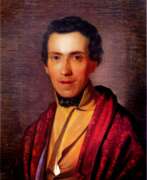

Adrian Ludwig Richter was a German Romanticist and Biedermeier painter.
Ludwig Richter studied painting at the Dresden Academy of Art. His travels, especially to Italy, played an important role in the further development of his talent, during which Richter was introduced to the Nazarenes and Joseph Anton Koch. After his return to Germany, the artist works as a draftsman at the Meissen Porcelain Manufactory, then teaches landscape painting at the Dresden Academy.
Since the late 1830s Richter is increasingly active as an illustrator (including for publications of fairy tales by the Brothers Grimm). Having made about 3,000 woodcuts for 150 works of art, Richter became one of the most popular artists in Germany. At the same time, 'large format painting' seems to recede into the background for him. A developed eye disease, which made the artist almost blind, forced him to leave painting in 1873.
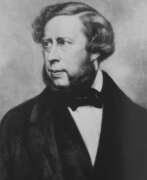

Julius Schoppe was a German painter of the mid-nineteenth century. He is known as a painter and graphic artist, famous for his portraits during the Biedermeier era.
Julius Schoppe studied Italian art in Rome and copied works by Raphael, Titian and Correggio. His copies of Raphael's paintings were included in the collection of the King of Prussia and were exhibited in Sans Souci. The master was also the author of landscapes, historical and genre paintings, as well as an original series of "living paintings" that were admired for their grace and painterly authenticity. He was a professor at the Berlin Academy of Fine Arts.
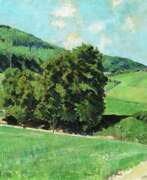

Karl Schröder-Tapiau was a German painter.
He studied at the Prussian Academy of Arts, then at the Karlsruhe Academy of Arts, then settled in Dachau and after World War I he co-founded the Dachau Artists' Group (later the Dachau Artists' Association).
Karl Schröder-Tapiau painted mainly portraits and landscapes, as well as works in the Biedermeier style with touches of Impressionism. He is considered an outstanding regional painter for his landscapes with views of Dachau.
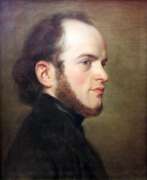

Adolph Friedrich Erdmann von Menzel was a German Realist artist noted for drawings, etchings, and paintings. Along with Caspar David Friedrich, he is considered one of the two most prominent German painters of the 19th century, and was the most successful artist of his era in Germany. First known as Adolph Menzel, he was knighted in 1898 and changed his name to Adolph von Menzel.
His popularity in his native country, owing especially to his history paintings, was such that few of his major paintings left Germany, as many were quickly acquired by museums in Berlin. Menzel's graphic work (and especially his drawings) were more widely disseminated; these, along with informal paintings not initially intended for display, have largely accounted for his posthumous reputation.
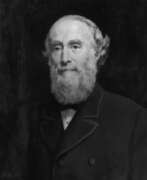

Anton Zwengauer was a German painter of the mid-19th century. He is known as a landscape painter and is considered a representative of the Biedermeier artistic movement.
Zwengauer traveled extensively in the Alps early in his career, creating sketches and watercolors. His painting "Sunset at Dachauer Moos" brought him recognition, and "sunsets" became his characteristic subject, known as "Zwengauers". The artist sought to convey the inner strength and peace of nature, often depicting sunsets and creating impressive lighting effects through simple means.
